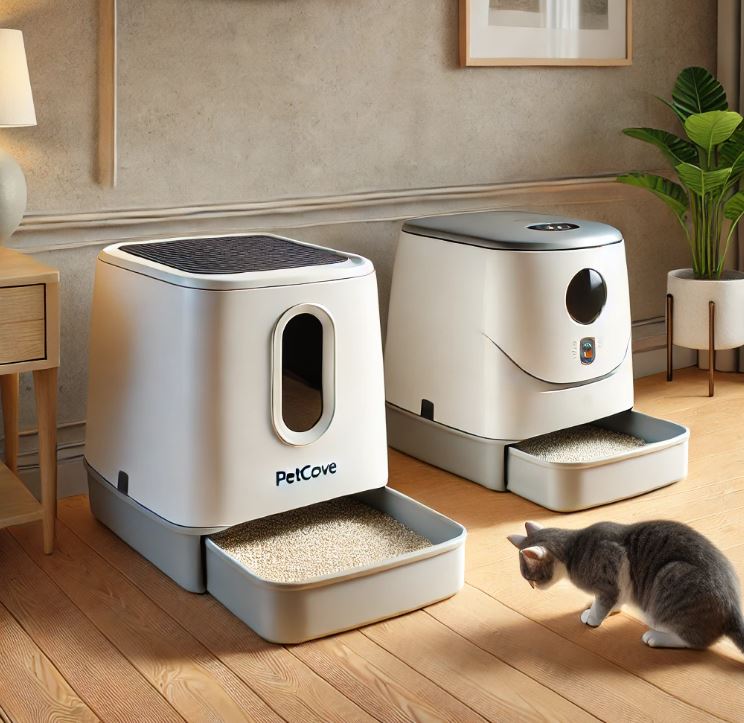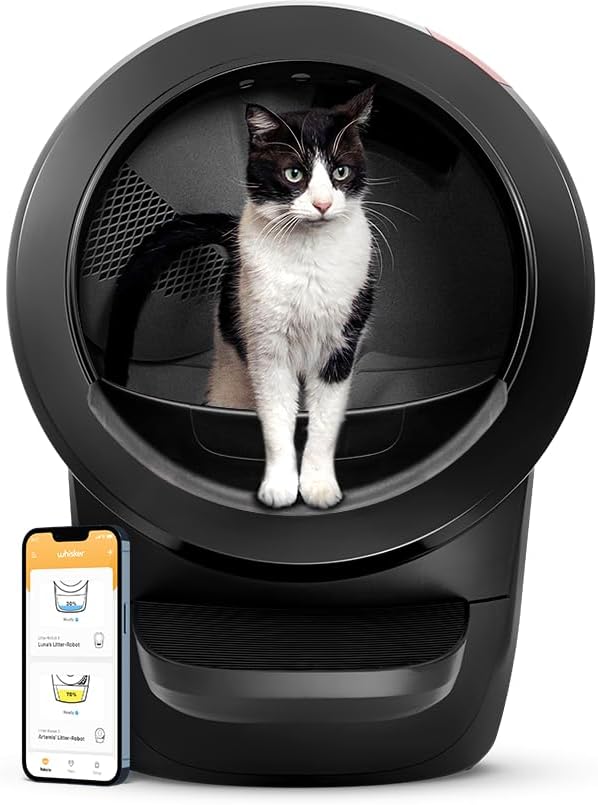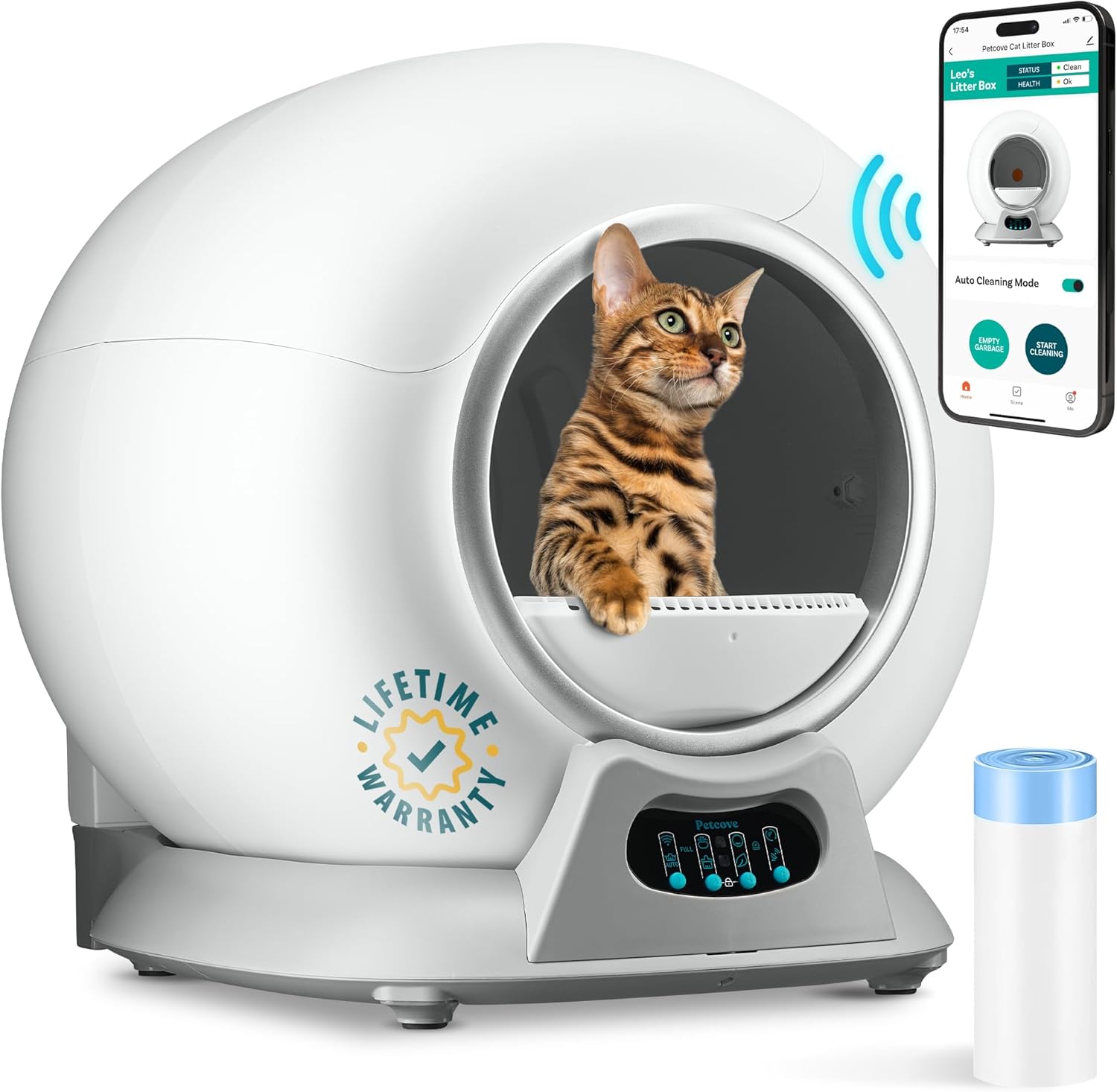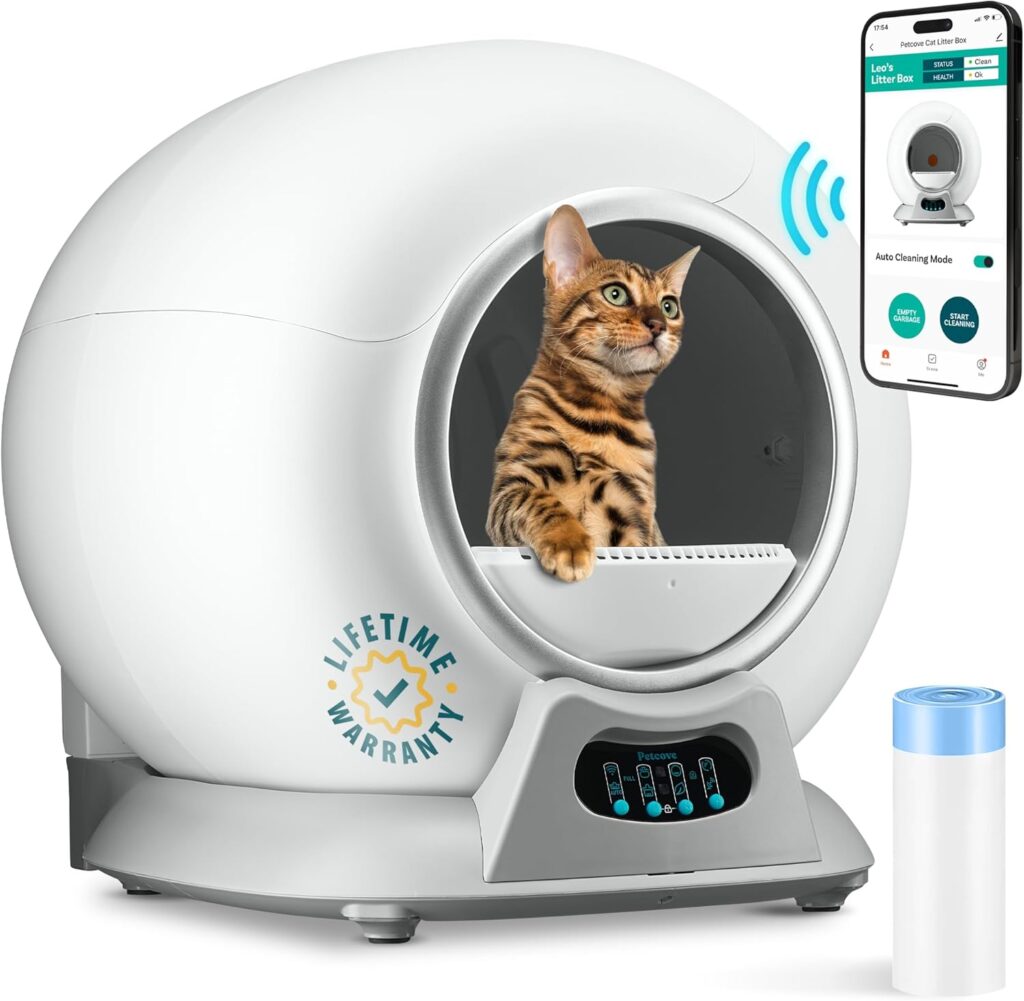I'm a participant in the Amazon Services LLC Associates Program, an affiliate advertising program designed to provide a means for me to earn fees by linking to Amazon.com and affiliated sites.
When deciding between the Petcove vs Litter Robot, it’s crucial to understand their differences and what each offers. Both are leaders in the automatic litter box market, but their features, technology, and user experience can vary significantly. This comprehensive comparison covers the pros and cons of each, highlighting the major differences and helping you make an informed decision.
Feature | ||
|---|---|---|
App Integration | Detailed insights, SmartScale® tracking | Basic notifications and controls |
Odor Control System | Sealed waste drawer, carbon filter | Open waste tray, basic filtration |
Cat Compatibility | Multi-cat | Single/multi-cat |
Noise Level | Quiet | Low |
Maintenance | Easy, modular | Simple, quick |
Price |
Key Takeaways: Petcove vs Litter Robot
- Smart Features: Both models provide smart app connectivity, but the Litter-Robot offers more detailed insights through its proprietary app.
- Odor Control: While both have efficient odor management systems, the Litter-Robot’s sealed waste drawer and carbon filter offer superior odor containment.
- Ease of Use: Petcove focuses on a straightforward, no-frills setup, while Litter-Robot offers advanced customization options for a personalized experience.
Comparison of Petcove and Litter-Robot
1. Features and Technology
The Litter-Robot is equipped with advanced technology like the OmniSense™ detection system, which tracks litter levels, cat activity, and waste drawer fullness through the Whisker app. It also offers multi-cat compatibility, making it suitable for larger households. Additionally, its QuietSift™ technology ensures low noise during cleaning cycles, and it includes features like night mode and customizable alerts.
On the other hand, the Petcove offers a more straightforward approach, with an automated self-cleaning mechanism that activates after each use. It supports basic app connectivity, providing notifications for when the waste compartment needs to be emptied, but lacks the in-depth tracking capabilities found in the Litter-Robot’s app. However, its simple design may be appealing to cat owners who prefer a no-fuss setup.
2. Odor Control and Maintenance: Litter Robot vs Petcove
Both models aim to minimize odor, but the Litter-Robot’s OdorTrap™ system utilizes carbon filters within a sealed waste drawer, effectively neutralizing smells. This design keeps odors contained even when the waste drawer is nearly full, making it ideal for smaller spaces. The modular setup also makes it easy to clean and maintain.
Petcove, while effective, uses a simpler odor control system that may not be as efficient in smaller homes or multi-cat environments. Its open waste tray design may require more frequent maintenance to prevent odors from spreading. However, its accessible structure allows users to clean the components quickly.
3. User Experience and App Integration
The Litter-Robot excels in user experience with its detailed app, which monitors cat weight, usage frequency, and health insights through SmartScale® technology. This feature allows owners to track individual cats’ behaviors and detect potential health issues early. It’s also compatible with various litter types, offering flexibility to cat owners.
Petcove, meanwhile, offers a simpler app with basic alerts and remote control options. It’s ideal for users who prefer minimal notifications and straightforward operation. While it may not provide the same level of insight as the Litter-Robot, it caters well to cat owners seeking ease of use without added tech complexity Innovasan.com.
Pros and Cons of Each Product
Product | Pros | Cons |
|---|---|---|
Litter-Robot | Advanced app integration, efficient odor control, quiet operation | Higher price point, more complex setup |
Petcove | Easy setup, affordable, basic app functionality | Less effective odor control, fewer customization options |
Major Differences Between Petcove and Litter-Robot
- Technology Integration: The Litter-Robot offers more advanced technology, including detailed tracking and weight monitoring, making it a more comprehensive solution for multi-cat households.
- Odor Management: With its sealed drawer and carbon filter system, the Litter-Robot provides superior odor control compared to Petcove’s open tray design.
- User Interface: The Litter-Robot’s app delivers in-depth analytics and customization options, while Petcove focuses on simplicity, offering basic controls suitable for users who prefer minimal tech involvement.
Recent Developments in Automatic Litter Box Technology
In recent updates, Litter-Robot introduced firmware enhancements for improved object detection accuracy, minimizing cycle interruptions. They also added the “Always Go Home” feature, ensuring the unit returns to its default position after each cleaning cycle. These updates demonstrate Whisker’s commitment to refining user experience through software improvements.
Petcove, on the other hand, has been focusing on expanding its app capabilities with upcoming features for better cat health monitoring. Their latest models also aim to improve odor control efficiency, responding to user feedback for better performance in smaller spaces.
Top Experts and Entities in the Field
- Whisker Lab: Innovates with advanced health-tracking features in the Litter-Robot series, providing pet owners with actionable insights into their cat’s health.
- PetTech Innovations: Specializes in developing app-integrated litter box solutions like Petcove, focusing on user-friendly and accessible technology for everyday use.
- EcoCat Solutions: Works on sustainability aspects, developing eco-friendly automatic litter box designs using recycled materials and biodegradable liners.
Feature | ||
|---|---|---|
App Integration | Detailed insights, SmartScale® tracking | Basic notifications and controls |
Odor Control System | Sealed waste drawer, carbon filter | Open waste tray, basic filtration |
Cat Compatibility | Multi-cat | Single/multi-cat |
Noise Level | Quiet | Low |
Maintenance | Easy, modular | Simple, quick |
Price |
Other Interesting Articles
- Furbo Cat Treats: Which Treats Work With Furbo?
- Furbo Mini vs Furbo 360: Best Furbo Treat Dispenser
- Best Dog Camera Treat Dispenser: Which One Wins?
- Best Cat Dry Food for Indoor Cats
Author
Written by PetsPal, an expert in pet care products and reviews. For more insights and detailed product information, visit PetsPal.
Setup and Installation Guide
Setting up both the Petcove and Litter-Robot is designed to be straightforward, but each product comes with specific steps to ensure a smooth installation process:
- Litter-Robot Setup: The Litter-Robot is a plug-and-play device. Once unpacked, users need to place the unit on a flat surface near a power outlet. After plugging it in, users can download the Whisker app to connect the device via Wi-Fi. The app provides step-by-step instructions for linking the unit, setting up notifications, and customizing the cleaning schedule. It’s recommended to add some familiar litter initially to help acclimate your cat.
- Petcove Setup: Petcove’s installation is equally simple, focusing on accessibility. Once assembled, users place the litter tray and adjust the cleaning mechanism following the manual’s instructions. The Petcove app offers basic connectivity features, allowing users to control the device remotely. However, its setup does not require as much app interaction compared to the Litter-Robot, making it a good option for those who prefer minimal tech involvement.
Maintenance Requirements
Proper maintenance ensures both the Petcove and Litter-Robot function optimally over time. Each product has its specific maintenance needs:
- Litter-Robot Maintenance: This model includes modular components, making it easy to disassemble and clean. Users should empty the waste drawer every few days or when notified by the app. The unit also features a sealed waste drawer and carbon filters, which need periodic replacement to maintain odor control. A monthly deep clean of the main unit is recommended, which involves removing the globe and wiping down the interior surfaces.
- Petcove Maintenance: Petcove is designed for quick and straightforward maintenance. The open waste tray needs to be emptied every 2-3 days, depending on usage. While it doesn’t have as advanced a filtration system as the Litter-Robot, users can easily clean the tray and rake mechanism with mild soap and water. Monthly maintenance involves disassembling the device to check for any clogs or buildup, ensuring smooth operation.
Frequently Asked Questions (FAQ)
Q: Are both the Litter-Robot and Petcove suitable for multiple cats?
A: Yes, both models are designed to accommodate multi-cat households. The Litter-Robot offers more advanced tracking for individual cats through its app, while Petcove supports multiple cats with less detailed monitoring.
Q: Do I need to use a specific type of litter?
A: The Litter-Robot is compatible with most clumping litters, but it’s recommended to use ones with minimal dust to ensure optimal performance. Petcove also works with various clumping litters; however, it’s essential to avoid silica or non-clumping types as they may interfere with the self-cleaning mechanism.
Q: How does the warranty coverage differ between the two?
A: The Litter-Robot typically comes with a one-year warranty, with options to extend it for an additional fee. Petcove also offers a standard one-year warranty, but their customer service may not be as comprehensive in terms of support for extended issues.
Q: What should I do if my cat is hesitant to use the new litter box?
A: For both models, placing the new litter box next to the old one for a transition period often helps. Using familiar litter and treats to encourage exploration can also make the process smoother.
Q: How often should I replace parts like filters or trays?
A: For the Litter-Robot, it’s advisable to replace carbon filters every 3-4 months for optimal odor control. Petcove does not use the same filtration system but requires periodic cleaning of the rake mechanism to avoid clogging.




